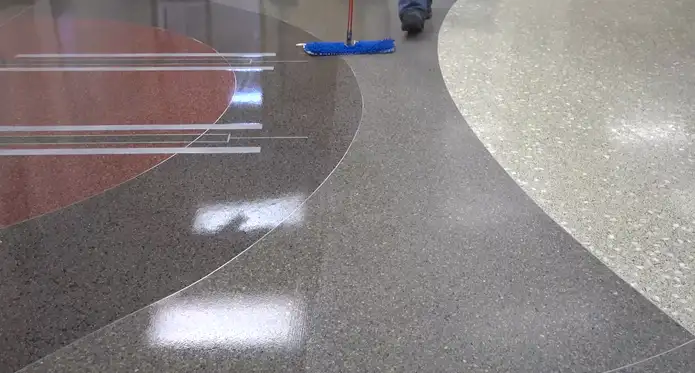Last Updated on March 9, 2023
The most prevalent issue associated with terrazzo floors is the presence of stains, which can be hard to remove and can cause the floor to appear dull. In some cases, the stains may be permanent.
While stain-resistant sealants can help to prolong the life of your terrazzo floor, eventually, the sealant will wear away, and the stains will start to show. If your terrazzo floor is stained, it can be tough to know how to clean stained terrazzo floors without making the problem worse.
We’re here to help. Our guide will lead you to effectively clean terrazzo without causing any damage. Plus, we’ll give you some helpful tips for preventing stains.
Methods on How to Clean Stained Terrazzo Floors
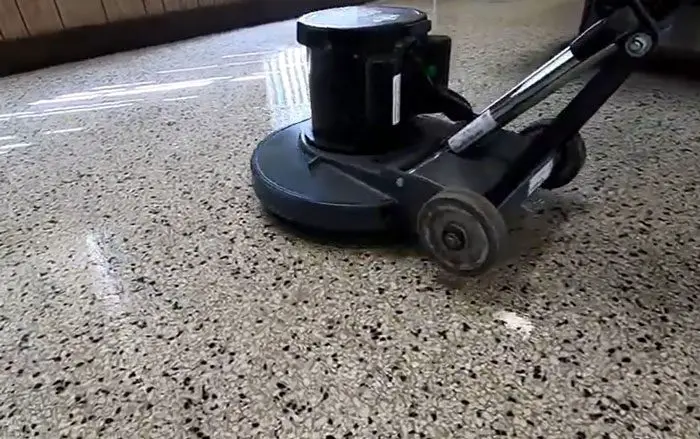
Before you start the cleaning process, it’s important to identify the type of stain you’re cleaning. The following are the most common types of stains found on terrazzo floors:
Organic Stains: These include food and drink spills, as well as mud and gravel, tracked in from outside.
Inorganic Stains: These are usually caused by chemicals, such as paint or grease. Be especially careful when cleaning these types of stains, as they can be corrosive.
Water Stains: These can be caused by a leaky roof or pipe or by wet mopping the floor without correctly drying it afterward.
Once you’ve identified what kind of stain it is, you can begin the cleaning process. You have to be careful while choosing the cleaning supplies and method you use, as some can damage the floor. The following steps will teach you how to clean stained terrazzo floors.
Removing Organic Stains
There are a few ways that you can deal with removing organic stains from terrazzo flooring. One way is to use a poultice. A poultice is a paste that you can make from a variety of materials, including Fuller’s earth, diatomaceous earth, or kaolin clay.
You’ll need to mix the poultice with water to form a thick paste, then apply it to the stain and cover it with plastic wrap. Leave the poultice in place for 24 hours, then remove it and scrub the area with a stiff brush.
Another way to remove an organic stain is to use oxalic acid. Oxalic acid is a powerful cleaning agent that can be found in many household cleaners. Be sure to read the labels carefully and follow the instructions, as oxalic acid can be harmful if used incorrectly. Once you’ve applied the oxalic acid, rub it in with a brush and rinse away the residue.
If you’re dealing with a tough organic stain, you may need to try a few different methods before you find one that works. The important thing is to be patient and to avoid using too much force, as this can damage the terrazzo.
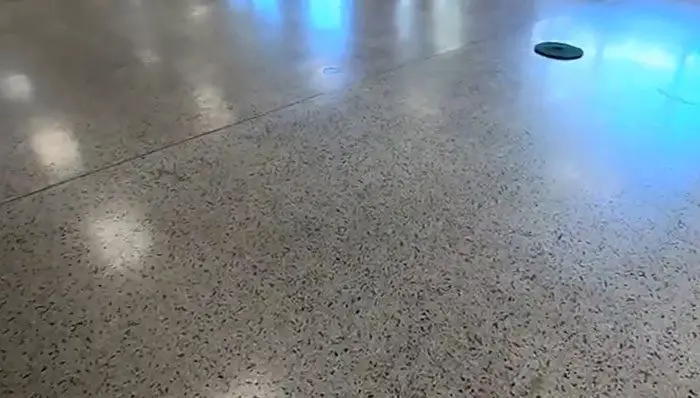
Dealing with Inorganic Stains
Inorganic stains can easily be removed from your floors with a few easy steps. First, determine exactly what type of stains you’re dealing with.
Water-based stains can usually be removed with a mild detergent and some elbow grease. Oil-based stains may require a stronger cleaner, such as white vinegar or mineral spirits. Once you’ve determined the best way to attack the stain, it’s time to get to work.
Assuming that you are dealing with a water-based stain, start by sweeping or vacuuming it to remove loose schmutz. Next, make a solution with warm water and detergent and begin scrubbing the floor with a soft brush.
If the stain is proving to be stubborn, be sure to let the solution sit for a few minutes before scrubbing again. Once the stain is gone, rinse the area with clean water and allow the floor to air dry.
Treating Water Stains
Water stains can be a stubborn problem, especially on porous surfaces like terrazzo. The good news is that there are a few simple steps to remove water stains from floors.
First, you’ll need to identify the source of the stain and make sure that it’s clean and dry. If the stain is coming from a dirty mop head or sponge, be sure to clean these items before proceeding.
Next, dampen a clean cloth with distilled water and gently blot the stain. For stains that are still visible, you can try using a mild detergent or white vinegar solution.
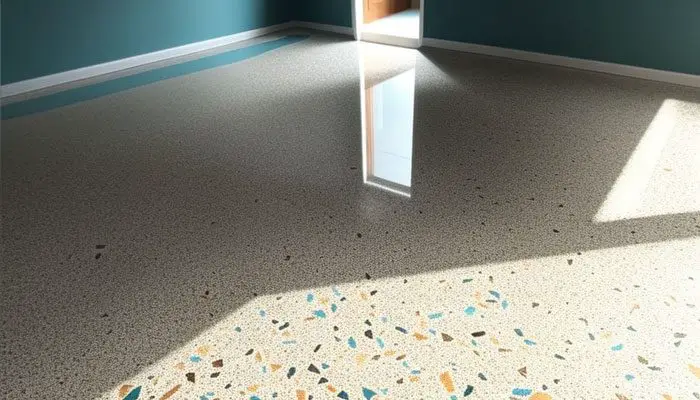
Once the stain has been removed, be sure to dry the area thoroughly to prevent new stains from forming. With a little patience and elbow grease, you should be able to get rid of water stains on your terrazzo floors.
If you have a large area of a stained floor, you may want to consider renting a floor scrubber or buffer. This will make the job easier and will help to ensure that you don’t miss any spots.
It is a beautiful and durable flooring option for your home, but they do require some special care to keep them looking their best. It has become easier over the years to keep your terrazzo floors clean and stain-free.
Whenever People Clean Terrazzo Floors : Mistakes
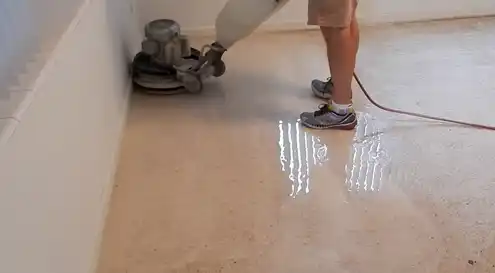
There are a few common mistakes that people make when it comes to cleaning terrazzo floors. Below are six of the most common mistakes:
Using the wrong cleaning solution: Many people believe that they can use any type of cleaning solution on their terrazzo floors, but this is not the case. Traditional cleaning products can actually damage the floor, making it more susceptible to scratches and stains. Instead, use a gentle pH-neutral cleaner specifically designed for terrazzo.
Scrubbing too hard: Another common mistake is scrubbing the floor too hard in an attempt to remove tough stains. Although, this can end up damaging the surface of the floor. To avoid this, make sure you have a soft-bristled brush or sponge when cleaning terrazzo.
Not mopping properly: When mopping, always use a damp mop rather than a wet one. Otherwise, you run the risk of leaving water spots on the floor. Also, be sure to change your mop water frequently to avoid spreading mud and grime around. The grout won’t be an issue since it’s not tile flooring.
Using the wrong mop: It’s important to use a soft mop instead of a hard one when cleaning terrazzo. Harder bristles can damage the delicate appearance of the floor. Instead, opt for a mop with softer bristles or even a microfiber cloth.
Forgetting to rinse: After you’ve mopped, be sure to rinse the floor with clean water. This will remove any leftover cleaner or soap residue, which can dull the floor’s shine. Rent a floor buffer or scrubber if you want to clean a large area.
Forgetting to polish: After cleaning, you should apply a sealant or polish to the floor. That way, you can help protect the terrazzo from future damage and make it easier to keep clean. Without polishing, terrazzo floors can quickly become dull and lackluster.
Helpful Tips for Preventing Stains from Terrazzo Floors
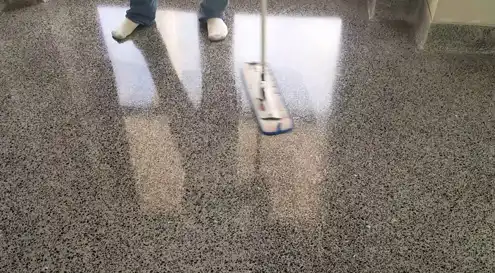
Terrazzo floors are stylish, but they are susceptible to stains if not properly cared for. Here are a few tips you can use to help prevent stains from appearing on your terrazzo floor:
- Sweep or vacuum regularly to remove the trash before it has a chance to become embedded in the floor.
- Mop with a solution of warm water and mild soap, taking care to avoid puddles.
- Wipe up spills immediately with a clean, dry cloth. If a stain does occur, treat it with a gentle cleaning solution and rinse well.
- Have your floor professionally cleaned and sealed every few years to keep it looking its best.
- Consider placing mats or rugs at entrances to help trap contaminants before they get on your floor.
- Cement-based terrazzos are more susceptible to staining than those made with epoxy, so be sure to use the appropriate cleaner for your type of floor.
- It is not tile or stone. It is a floor made of concrete with small pieces of aggregate embedded in it.
By following these simple tips, you can help keep your terrazzo floor looking like new for years to come.
What is The Cause of Stains on Terrazzo Floors?
Terrazzo floors are beautiful and durable, but they can be susceptible to staining. The cause of these stains is often unknown, but there are a few possible explanations.
One possibility is that the floor was not sealed properly before use. If the sealant is not applied correctly, it can leave the floor porous and susceptible to staining.
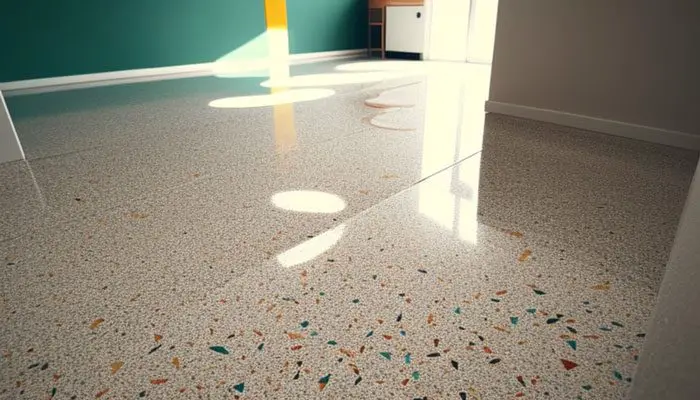
Another possibility could be that it was cleaned with a harsh cleaner that removed the sealant. This can also leave the floor vulnerable to staining.
Finally, it is also possible that the stains are simply due to residue and grime that has accumulated over time. Whatever the cause, it is important to take care as you clean Terrazzo flooring to prevent further staining.
FAQs
Can I Use Baking Soda to Clean Terrazzo Floors?
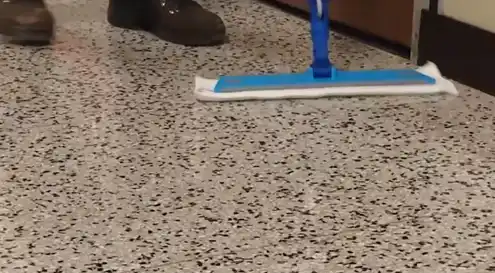
Baking soda can be used to clean terrazzo floors, but make sure to use it carefully. Baking soda is a mild abrasive, so it can harm the floor if it is not used properly. When cleaning with baking soda, apply it with a soft cloth or brush and minimize pressure. Clean the floor well and rinse it well after.
Is it Possible to Seal Terrazzo Floors?
A terrazzo floor can be sealed, which will help to protect them from staining and discoloration. Sealing will also make the floors easier to clean and maintain. There are a variety of sealants available, and the best one for your floor will depend on the type of terrazzo and the level of protection you need. You can consult with a professional to find the best sealant for your needs.
How Often Should I Clean My Terrazzo Floors?
Terrazzo floors should be cleaned regularly to prevent particle build-up. The frequency of cleaning is determined by the amount of foot traffic in the area. For example, hallways and foyers that see a lot of foot traffic will need to be cleaned more often than less-trafficked areas such as bedrooms or home offices.
A good rule of thumb is to sweep or vacuum the floor at least once a week and mop it with a neutral pH cleaner twice a month. If the floor starts to look dull or lackluster, regular cleaning may be necessary. With proper care, terrazzo floors can last for many years.
Can Terrazzo Floors Be Refinished?
It is possible to have terrazzo floors refinished, but the process is labor-intensive and requires special equipment. The first step is to grind the floor to remove any existing sealer or coating. Next, the floor is filled with epoxy resin, which is then smoothed to create an even surface.
Once the epoxy has cured, it is time to apply the new finish. This can be done using a polishing machine or by hand, depending on the size of the floor and the desired level of shine.
Are Terrazzo Floors Easy to Maintain?
Terrazzo floors are easy to maintain. They are resistant to staining and fading, and they do not require regular sealing or waxing. Terrazzo floors are also easy to clean; sweeping and mopping with mild soap is usually all that is needed to keep them tidy, clean, and new.
The fact that Terrazzo floors are more durable than many other types of flooring makes them a good choice for high-traffic areas. For these reasons, Terrazzo floors are ideal for homeowners who want a low-maintenance flooring option.
Final Thoughts
Now that you know the basic process for cleaning terrazzo floors, you can begin to work on removing any stains that have built up over time. Depending on the severity of the stain, it may be necessary to use a stronger cleaning solution or scrub the area more vigorously.
We hope this guide has helped teach you how to clean stained terrazzo floors. We wish you the best of luck in keeping your terrazzo floors looking their best. Thanks for reading.

